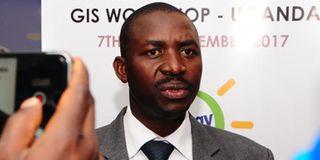‘Lack of data limits power reach’

Assistant commissioner in charge of electrical supply at the Ministry of Energy Abdon Atwine speaks during the GIS workshop in Kampala last week. Photo by Rachel Mabala
What you need to know:
- According to the technical advisor on energy, Mr Martin Kretschmer, with GIS, mapping of electricity network, utility and generation sites will be a lot easier and therefore easy to provide related services.
- Solution manager at Esri, an international supplier of geographic information system software, Mr Clifford Okembo, said electricity sector players, including the regulator need to have systems that relate and talk to each other, a technology that is available.
Kampala. Scanty data and lack of proper coordination among the power industry players is constraining the effort to accelerate the availability of electricity to a much wider national coverage.
This is worsened by the poor quality of data collected due to lack of tools to do the work or obsolete gadget being used to access and analyse critical raw data.
Additionally, the industry also faces capacity issues, considering that it is a highly specialised sub sector.
To address the above challenges, there is now push for wide adoption of a geographic information system (GIS), a system designed to capture, store, manipulate, analyse, manage, and present spatial or geographic data.
Speaking during the 6th utilities GIS workshop in Kampala last week, the assistant commissioner in charge of electrical supply at the Ministry of Energy, Mr Abdon Atwine, said availability of timely and accurate data is a challenge that the power sector is struggling with.
He said: “Collection of data in the field is not done in the way we would want because of inexperience, lack of proper technology and capacity challenges.”
He added: “There are many things that we would want to know but we cannot because of lack of accurate information. And without accurate information you cannot plan!”
As a result, services that could have been easily delivered, among them, widening access to electricity, have not been duly forthcoming.
Findings from the National Population and Housing Census 2014 undertaken by the Uganda Bureau of Statistics (UBOS), show that only about 20 per cent of the households in the country use electricity as their main source of energy for lighting.
Although electricity use has more than doubled and use of Tadooba (local paraffin lamp) has reduced by about 20 per cent, the biggest segment of the population is struggling to access power due to the technicality and the costs involved.
To deal with such challenges, particularly the issue of insufficient data, the workshop bought into the proposal to have GIS services, some of which include capturing and management of the type of data that the electricity industry need for proper coordination and service delivery.
“We should take advantage of technology and services offered by GIS to solve the challenges I have mentioned,” Mr Atwine said.
Solution manager at Esri, an international supplier of geographic information system software, Mr Clifford Okembo, said electricity sector players, including the regulator need to have systems that relate and talk to each other, a technology that is available.
This will solve a lot of the problems, including data management and monitoring that the sector needs to plug.
According to the technical advisor on energy, Mr Martin Kretschmer, with GIS, mapping of electricity network, utility and generation sites will be a lot easier and therefore easy to provide related services.




